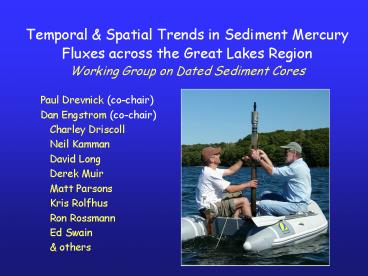Temporal PowerPoint PPT Presentation
1 / 10
Title: Temporal
1
Temporal Spatial Trends in Sediment Mercury
Fluxes across the Great Lakes RegionWorking
Group on Dated Sediment Cores
Paul Drevnick (co-chair) Dan Engstrom
(co-chair) Charley Driscoll Neil Kamman David
Long Derek Muir Matt Parsons Kris Rolfhus Ron
Rossmann Ed Swain others
2
Key Questions
- How much has Hg deposition increased during the
industrial period? - Are there spatial differences related to distance
from local Hg emission sources? - What are the recent trends in Hg deposition over
the last 30 years -- and do they vary across the
region? - Are trends in Great Lakes different from nearby
inland lakes? - Is there any relationship between Hg accumulation
in cores and Hg contamination in biota (e.g.
fish)?
3
Workgroup Products
- Publication synthesis of temporal and spatial
trends - Core-Hg database for Great Lakes Region
- Metadata Study info, Site info, Core info,
Dating, Hg analytical - Data
- Core interval depth
- Core interval age
- Sediment accumulation
- Hg Concentration
- Hg Accumulation
4
Data Sets
Region Contributor Cores
Michigan (Isle Royale) P. Drevnick 4
Michigan M. Parsons, D. Long 26 (6)
Vermont, New Hampshire N. Kamman 10
Ontario, Quebec D. Muir 18
Minnesota D. Engstrom, E. Swain 65
New York C. Driscoll 13
Great Lakes
L. Michigan R. Rossmann 52 (1)
L. Superior K. Rolfhus 10
L. Ontario C. Knights ?
L. Champlain N. Kamman 5
New Studies (to be included later)
Minnesota D. Engstrom, E. Swain 20
Western Great Lakes National Parks D. Engstrom, E. Swain 20
Experimental Lakes, Ontario D. Muir ?
5
Complexities of Sediment Records
- Sediments represent a net flux from multiple
sources and sinks - Sedimentary processes strongly influence the
record -- not a simple passive collector
6
Multiple Sources and Sinks
- Important contributing fluxes
- Catchment runoff
- 20-30 of wet deposition
- long lag time -- not steady state
- Erosion
- can overwhelm atm inputs in disturbed catchments
- Potentially significant losses
- Evasion
- (0-50 of atm inputs
- Outflow
- (not important if hydraulic residence time is
long)
7
Methodological Issues
- Concentration ?Accumulation
- Core dating is essential (accurate,
high-resolution) - Small dating errors have a large effect on Hg
accumulation rates
8
Sediment Redistribution Focusing
9
Sediment Hg Diagenesis
Not a Problem!
8 cores taken over 28 years from Nylandssjön
lake, Sweden Details of HgT profiles well
preserved No Hg diagenesis (but large changes in
MeHg)
Johan Rydberg et al., EST 2008
10
Recommendations
- Understand the complexity of the sedimentary
record - Select lakes with small, undisturbed catchments
and simple, flat-bottom bathymetry - Use multiple lakes and multiple cores, whenever
possible - (a single core is a dangerous thing)
- Dont over-interpret the data
- (much natural variability in sedimentary
archives that we cant easily resolve)
11
Whole-basin Hg accumulation from(a) multiple
cores(b) multiple lakes
Atmospheric Mercury Deposition Rates
Not Easy!
Swain et al., 1992
12
A Measure of Relative Change Hg Flux Ratios
20 Lakes, 20 Cores
13
Variability among cores
Lake 658, ELA (Hurley, Babiarz)
14
Global Increase in Hg Deposition Since the
Industrial Revolution ( 3 1)
Multi-core sediment archives from remote areas
(n 182 cores, 90 lakes)
Anthropogenic Hg emissions have altered Hg fluxes
to the same degree worldwide (the global
signal)

